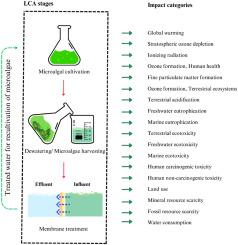当前位置:
X-MOL 学术
›
Environ. Res.
›
论文详情
Our official English website, www.x-mol.net, welcomes your
feedback! (Note: you will need to create a separate account there.)
Environmental impact assessment via life cycle analysis on ultrafiltration membrane fabricated from polyethylene terephthalate waste to treat microalgal cultivation wastewater for reusability
Environmental Research ( IF 7.7 ) Pub Date : 2024-03-16 , DOI: 10.1016/j.envres.2024.118687 Hemamalini Rawindran , Kuan Shiong Khoo , Baranitharan Ethiraj , Jun Wei Lim , Chin Seng Liew , Pei Sean Goh , Ratchaprapa Raksasat , Wai Hong Leong , Ravikumar Rajarathinam , Hui-Suan Ng , Woei-Yenn Tong , Mohammad Mahtab Alam
Environmental Research ( IF 7.7 ) Pub Date : 2024-03-16 , DOI: 10.1016/j.envres.2024.118687 Hemamalini Rawindran , Kuan Shiong Khoo , Baranitharan Ethiraj , Jun Wei Lim , Chin Seng Liew , Pei Sean Goh , Ratchaprapa Raksasat , Wai Hong Leong , Ravikumar Rajarathinam , Hui-Suan Ng , Woei-Yenn Tong , Mohammad Mahtab Alam

|
The current study had conducted the life cycle analysis (LCA) to assess the environmental impact of microalgal wastewater treatment via an integrated membrane bioreactor. The functional unit selected for this analysis was 1 kg of treated microalgal wastewater with contaminants eliminated by ultrafiltration membrane fabricated from recycled polyethylene terephthalate waste. Meanwhile, the applied system boundary in this study was distinguished based on two scenarios, namely, cradle-to-gate encompassed wastewater treatment only and cradle-to-cradle which included the reutilization of treated wastewater to cultivate microalgae again. The environmental impacts and hotspots associated with the different stages of the wastewater treatment process had clearly elucidated that membrane treatment had ensued the highest impact, followed by microalgal harvesting, and finally cultivation. Among the environmental impact categories, water-related impact was found to be prominent in the following series: freshwater ecotoxicity, freshwater eutrophication and marine ecotoxicity. Notably, the key performance indicator of all environmental impact, i.e., the global warming potential was found to be very much lower at 2.94 × 10 kg CO eq as opposed to other literatures reported on the LCA of wastewater treatments using membranes. Overall, this study had proffered insights into the environmental impact of microalgal wastewater treatment and its stimulus for sustainable wastewater management. The findings of this study can be instrumental in making informed decision for optimizing microalgal wastewater treatment and reutilization assisted by membrane technology with an ultimate goal of enhancing sustainability.
中文翻译:

通过对由聚对苯二甲酸乙二醇酯废料制成的超滤膜进行生命周期分析进行环境影响评估,用于处理微藻培养废水以实现可重复使用
目前的研究进行了生命周期分析(LCA),以评估通过集成膜生物反应器处理微藻废水对环境的影响。本次分析选择的功能单元是 1 千克经过处理的微藻废水,其污染物通过由回收的聚对苯二甲酸乙二醇酯废物制成的超滤膜消除。同时,本研究中的应用系统边界根据两种情况进行了区分,即从摇篮到大门仅包含废水处理和从摇篮到摇篮包括将处理后的废水再利用以再次培养微藻。废水处理过程不同阶段的环境影响和热点清楚地表明,膜处理的影响最大,其次是微藻收获,最后是培养。在环境影响类别中,与水相关的影响在以下系列中最为突出:淡水生态毒性、淡水富营养化和海洋生态毒性。值得注意的是,所有环境影响的关键绩效指标,即全球变暖潜势,在 2.94 × 10 kg CO eq 时被发现要低得多,这与报道使用膜进行废水处理的 LCA 的其他文献相比要低得多。总的来说,这项研究提供了关于微藻废水处理对环境的影响及其对可持续废水管理的刺激的见解。这项研究的结果有助于做出明智的决策,以优化膜技术辅助的微藻废水处理和再利用,最终目标是增强可持续性。
更新日期:2024-03-16
中文翻译:

通过对由聚对苯二甲酸乙二醇酯废料制成的超滤膜进行生命周期分析进行环境影响评估,用于处理微藻培养废水以实现可重复使用
目前的研究进行了生命周期分析(LCA),以评估通过集成膜生物反应器处理微藻废水对环境的影响。本次分析选择的功能单元是 1 千克经过处理的微藻废水,其污染物通过由回收的聚对苯二甲酸乙二醇酯废物制成的超滤膜消除。同时,本研究中的应用系统边界根据两种情况进行了区分,即从摇篮到大门仅包含废水处理和从摇篮到摇篮包括将处理后的废水再利用以再次培养微藻。废水处理过程不同阶段的环境影响和热点清楚地表明,膜处理的影响最大,其次是微藻收获,最后是培养。在环境影响类别中,与水相关的影响在以下系列中最为突出:淡水生态毒性、淡水富营养化和海洋生态毒性。值得注意的是,所有环境影响的关键绩效指标,即全球变暖潜势,在 2.94 × 10 kg CO eq 时被发现要低得多,这与报道使用膜进行废水处理的 LCA 的其他文献相比要低得多。总的来说,这项研究提供了关于微藻废水处理对环境的影响及其对可持续废水管理的刺激的见解。这项研究的结果有助于做出明智的决策,以优化膜技术辅助的微藻废水处理和再利用,最终目标是增强可持续性。











































 京公网安备 11010802027423号
京公网安备 11010802027423号